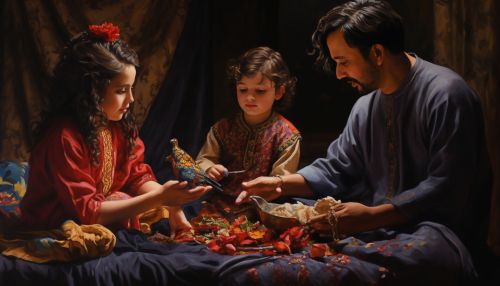Cultural transmission
Introduction
Cultural transmission, also known as cultural diffusion, is the process by which one culture shares, adopts, and incorporates aspects of another culture. It is a key mechanism in the evolution of cultures, societies, and civilizations and plays a significant role in shaping the diversity and commonalities we observe in human cultures worldwide.
Mechanisms of Cultural Transmission
Cultural transmission can occur through various mechanisms, including direct instruction, imitation, and learning through observation. These mechanisms can be categorized into vertical, horizontal, and oblique transmission.
Vertical Transmission
Vertical transmission refers to the transfer of cultural traits from parents to their offspring. This form of transmission is essential in maintaining the continuity of cultural practices, beliefs, and values within a family or a lineage.


Horizontal Transmission
Horizontal transmission involves the spread of cultural traits among individuals of the same generation. This type of transmission often occurs among peers and can lead to rapid cultural changes.
Oblique Transmission
Oblique transmission is the transfer of cultural traits from one generation to a non-descendant generation. This can occur, for example, through the influence of teachers, mentors, or media.
Factors Influencing Cultural Transmission
Several factors can influence the rate and direction of cultural transmission. These include population size, social structure, and the nature of the cultural traits being transmitted.
Population Size
The size of a population can significantly impact the rate of cultural transmission. Larger populations tend to have a higher rate of cultural innovation and transmission due to the increased number of potential transmitters and receivers.
Social Structure
The social structure of a society can also influence cultural transmission. Societies with a hierarchical structure may experience top-down cultural transmission, where cultural traits spread from higher social classes to lower ones.
Nature of Cultural Traits
The nature of the cultural traits being transmitted can also influence the rate and direction of cultural transmission. Traits that are beneficial or desirable are more likely to be adopted and spread within a culture.
Cultural Transmission and Evolution
Cultural transmission plays a crucial role in the evolution of societies and civilizations. It allows for the accumulation of cultural knowledge over generations, leading to the development of complex cultural practices and technologies.
Cultural Evolution
Cultural evolution refers to the change in cultural traits over time. This process is driven by various mechanisms, including cultural transmission, innovation, and selection.
Co-evolution of Culture and Language
The co-evolution of culture and language is a key aspect of human evolution. Language serves as a primary medium for cultural transmission, while culture shapes the development and use of language.
Cultural Transmission in the Digital Age
The advent of digital technology has significantly transformed the process of cultural transmission. The internet, social media, and digital communication tools have enabled rapid and widespread dissemination of cultural content, leading to the emergence of global digital cultures.


